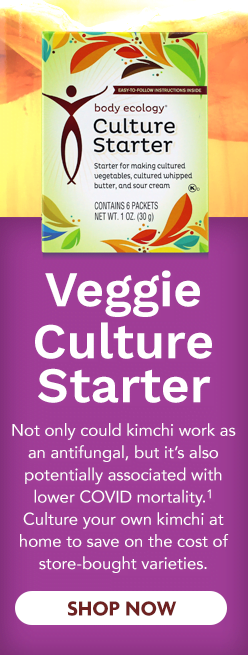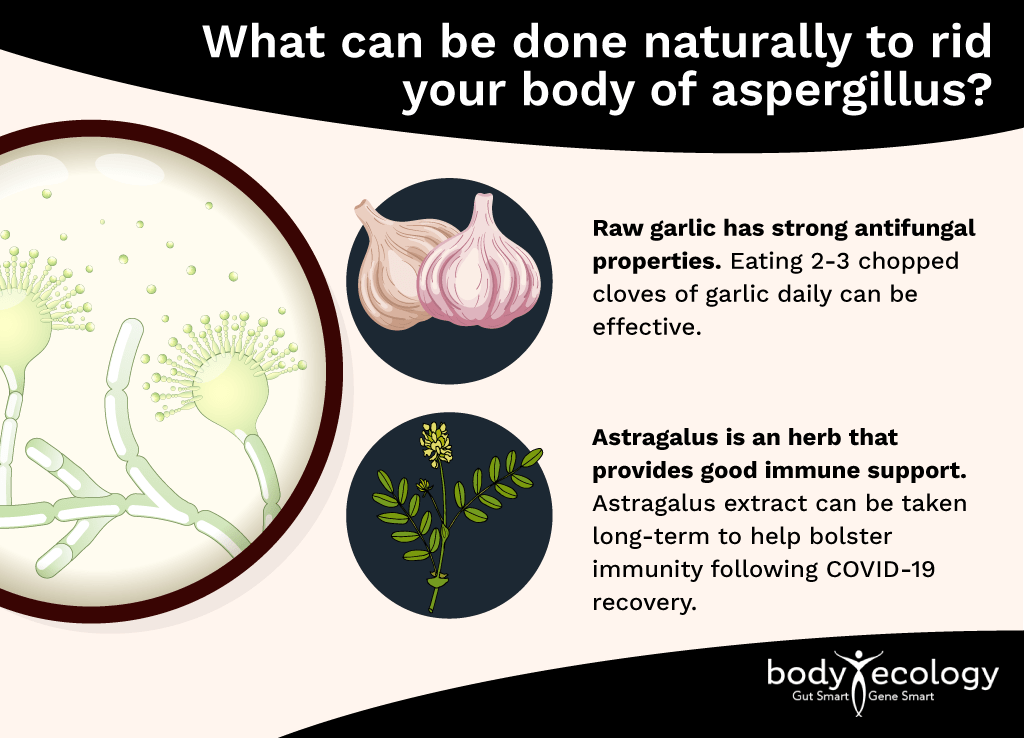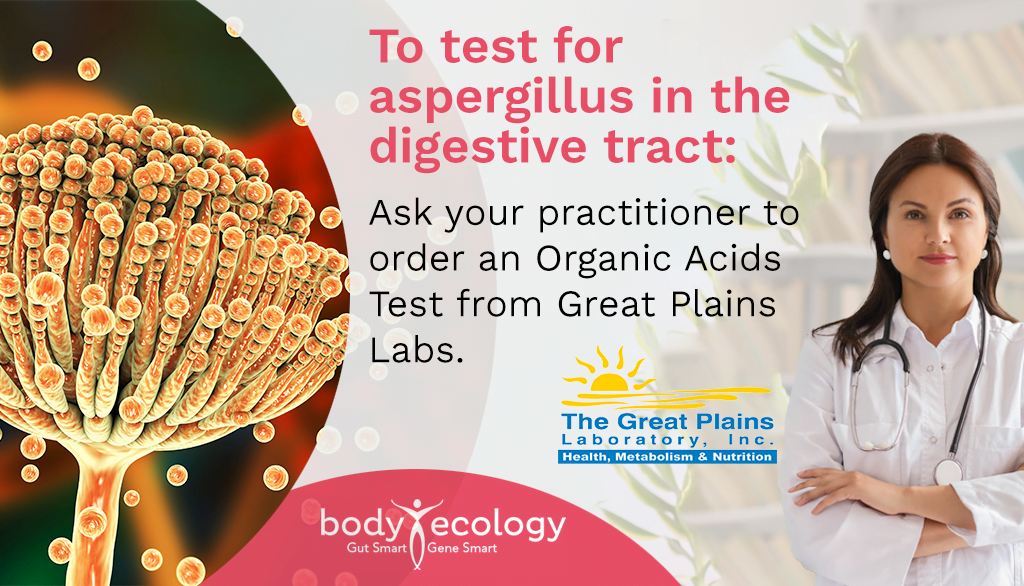
Have you recovered from COVID? This mycotoxin could be in your gut.
Aspergillus flavus, a mycotoxin, has recently been found in stool samples of the COVID-recovered, even when other symptoms of COVID-19 have cleared showing no active virus.* This demonstrates that the long-term impact of COVID-19 on gut health must be addressed.

Mycotoxins, such as Aspergillus flavus*, come from fungi (in this case, mold) and can potentially cause disease, including cancer and sometimes even death in humans.2
Aspergillus flavus is just one aspergillus species, of which there are many. Not all species of aspergillus manufacture mycotoxins, but A. flavus is one that does.3
Aspergillus flavus produces a toxin called aflatoxin, the most powerful, toxic, naturally-occurring liver carcinogen scientists have identified.4 In the plant kingdom, aflatoxins are a problem, especially in warm, humid regions where mold grows on dead plant tissue, infecting crops like peanuts, tree nuts, and maize fed to livestock.
In humans, accurately identifying Aspergillus flavus is difficult due to the existence of similar qualities in closely related species. Aspergillosis is the name of the infection caused when aspergillus spores are inhaled by humans and affect the lungs.
Aspergillus can cause symptoms as “mild” as an allergic reaction or as serious as a life-threatening event and so are categorized as allergic, chronic, or invasive.5 However, most people don’t contract aspergillosis, even though they take in the spores every day. Eradicating this mycotoxin can prove difficult but certainly is not impossible.
Aspergillus: What are the options for treatment?
Once a person is ill and/or is immunocompromised, like with COVID, they’re more susceptible to the type of co-lung and gut infection Aspergillus flavus can bring:
- Doctors have various means of testing to assess the presence of fungal infections like aspergillus and candida in the lungs of COVID-19 patients, depending on the probable severity.
- When the lungs are infected, early detection is necessary using several diagnostic tools, such as taking cultures, microscopic examination, and histopathology (studying the disease present in the tissues).
- Thorough testing is needed to ensure the proper course of treatment with such co-morbidities in COVID-19 patients.
In addition to blood and stool testing, doctors may order a chest X-ray, respiratory secretion test, or even a biopsy to properly identify infected lung tissue. Once identified, oral corticosteroids and antifungals may be prescribed. If the infection is severe, surgery to remove the fungal mass may be required if bleeding in the lungs has occurred.
With the seriousness of aspergillus infections and the vulnerability of patients post-COVID-19, it makes sense to introduce treatments that can be effective before more severe infections take hold.
Several of the markers indicate if you have aspergillus mold from food or water damage: 5-hydroxymethyl-2-furoic, Furan, is a byproduct of aspergillus and other fungal species. High levels of another marker, Furancarbonylglycine, is also an indicator of mold.
The cancer-causing aflatoxin suppresses the immune function in the gut, and other pathogenic organisms can grow.6 The aflatoxin may also damage the liver and kidneys.
How to eradicate aspergillus naturally
Conventional drugs are often first-line therapy when dealing with a serious infection. But supportive treatments can also help and are an important part of rebuilding the immune system once the pathogen has been eliminated.7,8

Treating plants and dairy products with lactobacillus has also been shown to be highly effective against various fungal strains.
A 2017 study looked at the effect of lactobacillus bacteria from local dairy products on inhibiting the growth of pathogenic microbes on MRS agar, a culture medium used to grow lactobacillus bacteria.9 After isolating eight lactobacillus species, scientists found that about 70 percent of the isolates had been shown to inhibit fungal growth on agar.
The Lactobacillus alimentarius and Lactobacillus delbrueckii species had a significant antifungal effect on Penicillium chrysogenum and Aspergillus flavus. With the exception of bacteriocin, lactic acid, and acetic acid, the inhibiting substances were produced by these beneficial bacteria. More research is needed to determine if results like these could apply to humans.
Other promising studies have been conducted on the effects of lactobacillus bacteria on aspergillus and other fungal strains.10 One study examined several lactobacillus strains found in the traditional Korean dish kimchi (see our article on the benefits of kimchi for gut health).11
In the study, researchers discovered that Lactobacillus sakei strains produced an antifungal substance related to its production of organic acid compounds. (L. sakei bacteria can also be found in fermented vegetables, not just kimchi.)
While these studies were conducted by the food industry as a means of making food products safer for human consumption, the potential for human benefit is apparent.
Body Ecology offers outstanding lactic-acid-containing products that combine beneficial microbes with other important nutrients to support gut health and fire up immunity.
We know that fermented foods and drinks containing Lactobacillus acidophilus and other beneficial microbes are a much more potent choice for incorporating beneficial bacteria into your inner ecosystem. Yes, probiotic supplements have their place. But they don’t have the diversity needed for a strong immune system.
Looking for another potent source of food-based lactobacillus probiotics? Consider Body Ecology’s Cultured Vegetable & Cultured Butter Starter.
Our Veggie Culture Starter helps make tasty, cultured vegetables, and using a starter significantly boosts the number of beneficial microbes in the finished product. Many people have reported that eating cultured vegetables has helped take away cravings for sweets, soft drinks, bread, pasta, dairy, fruit, and other expansive foods not allowed on the diet. It certainly helps mitigate their damage to the body.
Research suggests that Lactobacillus plantarum may help gut dysbiosis and other gut conditions.12 L. plantarum eats oxalates, is resistant to many antibiotics, and is also antiviral.13-15
Now that you know the potential – and probable – dangers of aspergillus, these latest findings, detecting aspergillus in the stool of COVID-recovered patients, are worth noting.
In the face of COVID-19, consuming fermented foods has never been more important: Fermented vegetables may offer antifungal protection, help reduce COVID death risk, and even enhance vaccine effectiveness, if you make the personal choice to vaccinate.
REFERENCES:
- 1. Bousquet J, et al. Association between consumption of fermented vegetables and COVID-19 mortality at a country level in Europe. medRxiv 2020.
- 2. Magnussen A, Parsi MA. Aflatoxins, hepatocellular carcinoma and public health. World J Gastroenterol. 2013 Mar 14;19(10):1508-12. doi: 10.3748/wjg.v19.i10.1508. PMID: 23539499; PMCID: PMC3602466.
- 3. Pfliegler WP, Pócsi I, Győri Z, Pusztahelyi T. The Aspergilli and Their Mycotoxins: Metabolic Interactions With Plants and the Soil Biota. Front Microbiol. 2020;10:2921. Published 2020 Feb 12. doi:10.3389/fmicb.2019.02921.
- 4. Hedayati MT, Pasqualotto AC, Warn PA, Bowyer P, Denning DW. Aspergillus flavus: human pathogen, allergen and mycotoxin producer. Microbiology (Reading). 2007 Jun;153(Pt 6):1677-1692. doi: 10.1099/mic.0.2007/007641-0. PMID: 17526826.
- 5. The Lancet Respiratory Medicine. Chronic pulmonary aspergillosis: help is on the way. Lancet Respir Med. 2016;4:83.
- 6. Kulas J, Mirkov I, Tucovic D, Zolotarevski L, Glamoclija J, Veljovic K, Tolinacki M, Golic N, Kataranovski M. Pulmonary Aspergillus fumigatus infection in rats affects gastrointestinal homeostasis. Immunobiology. 2019 Jan;224(1):116-123. doi: 10.1016/j.imbio.2018.10.001. Epub 2018 Oct 13. PMID: 30348457.
- 7. Abdallah, Emad. (2017). Potential Antifungal Activity of Fresh Garlic Cloves (Allium sativum L.) from Sudan. Journal of Biotechnology Research. 3. 106-109.
- 8. Jin M, Zhao K, Huang Q, et al. Structural features and biological activities of the polysaccharides from Astragalus membranaceus. Int J Biol Macromol 2014;64:257-266.
- 9. Karami S, Roayaei M, Zahedi E, et al. Antifungal effects of Lactobacillus species isolated from local dairy products. Int J Pharm Investig. 2017;7(2):77-81. doi:10.4103/jphi.JPHI_9_17.
- 10. Mohamed G. Shehata, Ahmed N. Badr, Sobhy A. El Sohaimy, Dalal Asker, Tarek S. Awad, Characterization of antifungal metabolites produced by novel lactic acid bacterium and their potential application as food biopreservatives, Annals of Agricultural Sciences, Volume 64, Issue 1, 2019, Pages 71-78, ISSN 0570-1783, https://doi.org/10.1016/j.aoas.2019.05.002.
- 11. Huh CK, Hwang TY. Identification of Antifungal Substances of Lactobacillus sakei subsp. ALI033 and Antifungal Activity against Penicillium brevicompactum Strain FI02. Prev Nutr Food Sci. 2016;21(1):52-56. doi:10.3746/pnf.2016.21.1.52.
- 12. Yang Liu, Xinjie Yu, Leilei Yu, Fengwei Tian, Jianxin Zhao, Hao Zhang, Long Qian, Qun Wang, Zhengqing Xue, Qixiao Zhai, Wei Chen, Lactobacillus plantarum CCFM8610 Alleviates Irritable Bowel Syndrome and Prevents Gut Microbiota Dysbiosis: A Randomized, Double-Blind, Placebo-Controlled, Pilot Clinical Trial, Engineering, Volume 7, Issue 3, 2021, Pages 376-385, ISSN 2095-8099, https://doi.org/10.1016/j.eng.2020.06.026.
- 13. Liu Y, Jin X, Tian L, et al. Lactiplantibacillus plantarum Reduced Renal Calcium Oxalate Stones by Regulating Arginine Metabolism in Gut Microbiota. Front Microbiol. 2021;12:743097. Published 2021 Sep 24. doi:10.3389/fmicb.2021.743097.
- 14. Ahn, C., Collins-Thompson, D., Duncan, C., and Stiles, M. E. (1992). Mobilization and location of the genetic determinant of chloramphenicol resistance from Lactobacillus plantarum caTC2R. Plasmid 27, 169–176. doi: 10.1016/0147-619X(92)90018-6.
- 15. Sunmola AA, Ogbole OO, Faleye TOC, Adetoye A, Adeniji JA, Ayeni FA. Antiviral potentials of Lactobacillus plantarum, Lactobacillus amylovorus, and Enterococcus hirae against selected Enterovirus. Folia Microbiol (Praha). 2019 Mar;64(2):257-264. doi: 10.1007/s12223-018-0648-6. Epub 2018 Sep 29. PMID: 30267215.









